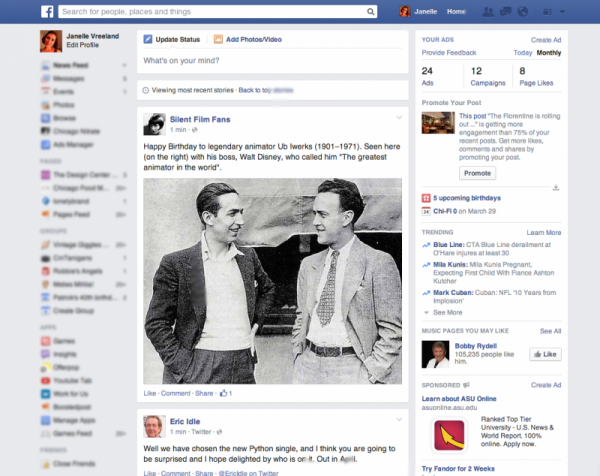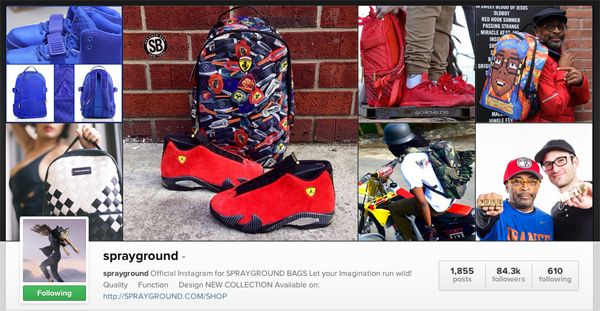
Making predictions is very difficult, especially in a field as complicated and as fast-paced as digital marketing. That being said, I’ve noticed some trends emerging recently and think that they point towards the overall direction content marketing will be headed in 2015. Here are my predictions on the evolution of content marketing next year.
The Importance of Social Media Subcultures
In the early days of the web, search engines were the primary way that people discovered content online. Google and Yahoo work by serving up the most relevant results based on keywords. However, this relevance wasn’t personalized at first, it was based on a judgment of relevance for the average person.
Social networks opened up a whole new avenue towards discovering online content, because they were inherently personalized. However, as our networks grew; Facebook, Twitter and many other social sites were forced to start filtering content based on what their newsfeed algorithms thought was most relevant to us.
This has been creating what many call the “echo-chamber” effect. Facebook determines what gets shown in your feed based on who you know, what your interests are and what posts you’ve liked or shared in the past. As this algorithm evolves and gets to know you better it inevitably begins to narrow whose posts you see and what types of content, opinions and voices you are exposed to.

The most interesting change happening from a marketing perspective is the intensification of online subcultures.
As who we know, what we like, and what we share begins to determine what we see, who we hear and where we hear it from, our experience of the web becomes more intensely focused around a narrower range of topics and a more focused social circle.
From Google’s socialization of search with Google+ or the extension of the Facebook “like” button to nearly every site online, our social ties are increasingly shaping our experiences online.
The web is one of the most dominant forces in the spread, creation and discussion of culture, and with this fragmentation of online experiences will come new, unique and highly specialized “echo-chamber” subcultures.
These groups are of unique importance to brands, because the degree of trust and loyalty amongst these niche subcultures means that once a brand or product or celebrity gains acceptance they are more likely to be embraced.
The only way brands can hope to do so is to choose which subcultures to go after and pay very close attention to the specific values, beliefs and ideas that define them.
Companies Will Continue to Become or Buy Niche Publishing Houses
Over the past few years, content marketing has become one of the most widely embraced new models for reaching audiences. The reason why content marketing has risen to prominence is because it flipped the old advertising model on its head.
Traditional advertising involved brands paying for the privilege to insert their message inside other’s content. This interruption model was the same for print, radio and other forms of advertising.
Content marketing proposed that instead of brands interrupting someone else’s content, that they defy best practices and attract an audience by creating their own content. Not only do you avoid bothering potential customers with messages they don’t want to hear, this approach also gives brands unprecedented ability to create stories and control their own content.
TV networks or magazines that hope to attract advertisers need to keep their content purposefully broad so that they can be relevant to many potential advertisers, but when brands control the content they don’t have to answer to anyone, except their audience they are trying to reach.

This freedom is the real benefit of content marketing; but it seems that even as more brands begin to pursue a content strategy, they are shying away from taking full advantage of the freedom this strategy allows.
Save for a few exceptions, brands have not leveraged content marketing’s real strategic potential to its fullest to date. The Red Bull Media House and a few other outliers have already demonstrated the potential rewards of doubling down on the strategy of becoming a niche publisher of quality, targeted content.
Even smaller players like PetFlow have shown that (even absent a multi-million dollar budget) publishing content that doesn’t appeal to everyone is the way to maximize your appeal to the people that matter.
Instead of just creating content as an extension of their website (even as a dedicated blog) brands will increasingly begin to either spin off, purchase, or build full-fledged content creation divisions.
This won’t be for only branded content, it will be high-quality targeted content to establish that brand as a tastemaker in their industry. This is because as online communities become more and more insular and specialized, piggybacking off of mainstream content will become less viable.
Number of Followers Won’t Equate to Influence
According to Jason Miller’s, Welcome To The Funnel, there are three types of thought leadership that all relate back to the content your business is creating: industry thought leadership, product thought leadership and organizational thought leadership.
Miller recommends applying these different types of thought leadership based on what your company does well and where the biggest opportunities lie.
“Bottom line: focus on the area(s) where you can make an impact and add value to the conversation instead of just adding noise,” said Miller.
With that said, you may not have heard of Marie Forleo, but the people who have heard of this thought leader are some of the most influential and powerful players in business and entrepreneurship. MarieTV has 136,000 YouTube subscribers and has had a wide-range of guests on her show from Tony Robbins to Arianna Huffington.
Marie herself has appeared on Oprah and leads a dedicated community of successful, aspiring men and women looking to achieve a better life and business. She might not have as many subscribers as some other more commonly known YouTubers, but this has little to no bearing on the amount of influence she wields as an industry thought leader.
The fragmentation of the social fabric of the web can be likened to the dynamic of a high-school cafeteria. There are many different cliques forming and each has their own social currency and way of appropriating and gauging influence. In each group, the popular kids are rarely the people with the most friends; rather, they are ones with the friends who matter the most.
Marie Forleo and her friends might signal social influence if you are part of the social subculture that calls itself “digital entrepreneurs,” but if you’re a part of the “anime enthusiast” subculture Marie Forleo wouldn’t matter to you even if she had a million subscribers.
So many social marketers are obsessed with “volumetrics.” Countless resumes are filled with statements like “Gained client +30K Instagram followers,” but all these measurements of volume are pointless. Those thousands of followers might as well be bots if they are not part of the subculture that will be receptive to your brand.
This volume-obsessed mindset typifies the “click-bait” mentality of trying to acquire as many views, clicks, likes and shares as possible. However, this exemplifies the old model of media creation where instead of appealing to customers, publishers were appealing to advertisers. It is important to become self-aware of your communities in order to best reach their members.
When your content is replacing your advertising, volume is meaningless and influence becomes the most important thing. Speaking the language of your target audience and embracing the subculture that is shaping their online lives is the only sure-fire way to create content that will appeal to them. If 2014 was the year of click-bait, 2015 will be the year of “clique-bait.” [Click to Tweet]
The New Role: Subculture Influencer
In much the same way that companies and brands will begin purchasing or creating hyper-niche publications, they will also begin pursuing endorsement deals with micro-celebrities that regularly produce their own content.
In his book Unleashing the Ideavirus, Seth Godin talked about the viral influencer as a “sneezer” (i.e. someone who spread ideas simply by embracing them). As mentioned in the previous section, these influential individuals don’t always have the biggest followings, but they do have a highly engaged and receptive audience. In addition, the ideal sneezer will have other sneezers who pay attention to what they say.
The emerging culture of online micro-celebrity bloggers, Twitter personalities, or Instagram stars is by no means new to social media marketing. The past few years have seen marketers begin to realize the power of small, distinctly influential online personalities. However, as communities continue to become ever more specialized, these influencers will start to be defined by different metrics than they currently are.
Instead of looking for micro-celebrities with lots of followers or likes, it will become increasingly important to tease out the actual composition of their following. An Instagram following of 10,000 might seem unimpressive, but if that following consists of 50 other sneezers relevant to the niche you’re going after, plus another 9,900 members of that same niche then that small-seeming number begins to look much bigger.

An example of a brand that is ahead of the curve is counter-culture backpack company Sprayground. Their Instagram boasts one of the most dynamic and dedicated followings and has created a thriving subculture. One key to their success has been maintaining and pursuing relationships with dozens of Instagram micro-celebrities.
Sprayground understands carefully picks these partners not based on the gross volume of followers they have, but rather on the clout they have within the community they’ve built.
Micro-celebrities are not new, but as the relative size of communities gets smaller and the dedication and connectedness of their members gets stronger, these micro-celebrities will begin to look much less like traditional celebrities and wield influence disproportionate to the number of followers they have.
YouTube Celebrities Will Fully Infiltrate the Mainstream
If someone tries to tell you that YouTube celebrities haven’t made much influence of mainstream culture, point them in the direction of the Green brothers. In just a few short years, YouTube celebrities John and Hank Green, of Vlogbrothers fame, have created an impact unlike nearly any other celebrity (online or otherwise).
While Hank Green has been busy managing VidCon (the biggest “in real life” gathering of YouTubers) and the wildly successful SciShow and CrashCourse channels, his brother John has been making even more of a splash.

John’s novel “The Fault In Our Stars” was propelled to such powerful reception (in large part due to his dedicated YouTube following) that it subsequently became a movie that enjoyed both critical and commercial success. Although the movie starred the young and charismatic Shalene Woodley and Ansel Elgort, John served as the main star vehicle for the movie.
The reason he was the driving force behind the films creation and promotion was not because of the artistic merit he imparted to the work (not to say the movie and book weren’t excellent), but because of the cult of personality surrounding his own personal brand.
YouTube is not the only forum that has seen creators embrace and cultivate hyper-targeted subculture followings, but it is among the first to see its once underground communities begin to affect mainstream culture.
The reason John Green’s fans went out to see The Fault In Our Stars was because they felt as if they had participated in the process of its creation. They had seen John’s relationship with Esther (a cancer patient and Vlogbrothers fan who sadly passed away) inspire him to write the novel. They saw his excitement when the book succeeded. And now they were going to see that movie no matter what.
What brands can learn from the Green brothers (and other YouTube creators) is that creating vibrant content and inviting participation can serve as the driving force behind building a community. Instead of simply putting content out, successful brands will begin to place the content consumers on the same level as its creators.
Mainstream Celebrities Will Increasingly Rely On The Web To Establish Influence
John Oliver’s show Last Week Tonight has quickly become a cultural force that is contending with long-entrenched, successful competitors like The Daily Show and The Colbert Report. Oliver’s program owes its success, in large part, to its decision to embrace the web for distribution.
Last Week Tonight’s debut show (typically the highest ranking episode) on HBO had a viewership of 1.1 million. However, over the course of the next few weeks, the clips John Oliver put out featuring the show’s main segments began to get double or triple the amount of views as the premiere episode.
Oliver’s show is by no means an isolated example of the power the Internet has to make a mainstream celebrity relevant. As people continue to consume more content online, and as their attention begins to be diverted by highly targeted micro-celebrities relevant to their unique niche, mainstream celebrities will find themselves being forced to compete for attention wherever it is that their potential audience is spending their time.
It used to be that getting your own TV show or record deal or Hollywood role was a ticket to success, but the shifting of the way we consume and discover content is changing that drastically. Now, people with their own TV show are finding that to maintain relevance they have to create content suited to an online audience as well.
Whereas an entire generation of kids who grew up wishing for fame imagined being on an ABC sitcom or starring in a big-budget blockbuster, tomorrow’s daydreaming kids will likely be imagining a very different image of super-stardom. Instead of longing for their own hit TV show, they’ll likely be dreaming about having their own hit YouTube channel.
With that said, businesses will increasingly need to reply on their online audience in order to find success with their content on other platforms. I’m by no means saying TV and other channels are no longer influential, but when I am saying is that the influence these platforms once controlled has been distributed across more networks, channels, platforms and devices as the web has grown.
Therefore, it’s important to establish authority online with your content in order to solidify your success across other media channels.
What are your predictions on how content marketing will evolve for 2015 and beyond? Share your best predictions in the comments below.


